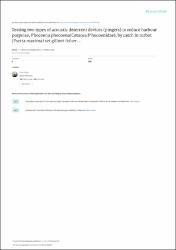| dc.contributor.author | Bilgin, Sabri | |
| dc.contributor.author | Köse, Özay | |
| dc.date.accessioned | 2020-12-19T19:42:29Z | |
| dc.date.available | 2020-12-19T19:42:29Z | |
| dc.date.issued | 2018 | |
| dc.identifier.citation | Bilgin, S. & Köse, Ö. (2018). Testing two types of acoustic deterrent devices (pingers) to reduce harbour porpoise, Phocoena phocoena (Cetacea: Phocoenidae), by catch in turbot (Psetta maxima) set gillnet fishery in the Black Sea, Turkey. Cahiers de Biologie Marine, 59(5), 473-479. https://doi.org/10.21411/CBM.A.D5B58D5B | en_US |
| dc.identifier.issn | 0007-9723 | |
| dc.identifier.issn | 2262-3094 | |
| dc.identifier.uri | https://doi.org/10.21411/CBM.A.D5B58D5B | |
| dc.identifier.uri | https://hdl.handle.net/11436/1919 | |
| dc.description | WOS: 000454999600008 | en_US |
| dc.description.abstract | Field experiments with Aquamark 100 and Aquamark 200 pingers were conducted in the bottom set gill net fishery for turbot in the Black Sea coast between March and June 2012. the aim of the experiment was to evaluate (i) the effectiveness of two types of pingers to reduce by catch rate of harbour porpoises, and (ii) the effects of pingers on the catches of the target fish species (Psetta maxima) and non-target fish species (Raja clavata, Suqualus acanthias and Trigla lucerna) in the turbot set gillnet fishery. A total of 246 specimens (95 P. maxima, 138 R. clavata, 8 P. phocoena, 4 S. acanthias and 1 T. lucerna) were caught during both Aquamark 100 and Aquamark 200 pingers trials. Catches of Psetta maxima and other fish species (Raja clavata, Suqualus acanthias and Trigla lucerna) were not affected by the sound of the pingers in the active nets. Catch of target P. maxima and non-target fish R. clavata were similar as were also for most caught species. 6 P. phocoena (2 in control and 3 in active nets with Aquamark 100) and 2 P. phocoena (1 in control and 1 in active nets with Aquamark 200) were caught in controls and active nets. There are no statistical differences between active and passive net catch per unit effort among the fish species and also cetaceans. As a conclusion, the acoustic signals clearly showed that these pinger types did not reduce by catch of harbour porpoise from the turbot gill net in the eastern Black Sea coasts, Turkey. the acoustic signals of both pinger types also did not affect the catch of target and non-target fish species. | en_US |
| dc.description.sponsorship | Recep Tayyip Erdogan University, Scientific Research Project [BAP 2010.103.03.2] | en_US |
| dc.description.sponsorship | The authors thank fishermen Sami Akmermer, Kazim Akmermer Ugur Akmermer and Ahmet Kalkavan for their help during the field studies. We would also like to thank two anonymous referees for their suggestions and criticism that clearly improved an earlier version of this manuscript. This study was supported by the Recep Tayyip Erdogan University, Scientific Research Project (BAP 2010.103.03.2). | en_US |
| dc.language.iso | eng | en_US |
| dc.publisher | Cahiers de Biologie Marine | en_US |
| dc.rights | info:eu-repo/semantics/openAccess | en_US |
| dc.subject | Harbour porpoises | en_US |
| dc.subject | Phocoena phocoena | en_US |
| dc.subject | Pingers | en_US |
| dc.subject | By catch | en_US |
| dc.subject | Black Sea | en_US |
| dc.subject | Turkey | en_US |
| dc.title | Testing two types of acoustic deterrent devices (pingers) to reduce harbour porpoise, Phocoena phocoena (Cetacea: Phocoenidae), by catch in turbot (Psetta maxima) set gillnet fishery in the Black Sea, Turkey | en_US |
| dc.type | article | en_US |
| dc.contributor.department | RTEÜ, Tıp Fakültesi, Temel Tıp Bilimleri Bölümü | en_US |
| dc.contributor.institutionauthor | Köse, Özay | |
| dc.identifier.doi | 10.21411/CBM.A.D5B58D5B | |
| dc.identifier.volume | 59 | en_US |
| dc.identifier.issue | 5 | en_US |
| dc.identifier.startpage | 473 | en_US |
| dc.identifier.endpage | 479 | en_US |
| dc.relation.journal | Cahiers de Biologie Marine | en_US |
| dc.relation.publicationcategory | Makale - Uluslararası Hakemli Dergi - Kurum Öğretim Elemanı | en_US |


















